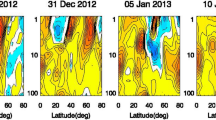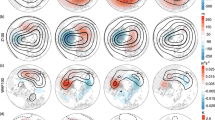Abstract
Using monthly stratospheric geopotential height at 20 hPa derived from the National Centers for Environmental Prediction/National Center for Atmospheric Research (NCEP/NCAR) reanalysis datasets, a planetary wave amplitude index (PWAI) is defined by wave numbers (WN) 1–3 over 55–75°N to indicate the strength of the stratospheric stationary waves. The vertical variability of the stratospheric stationary waves and their possible connection with the stratosphere–troposphere coupling have been investigated in the North Hemisphere winter [December–February (DJF)] for the period of 1950–2010. In terms of the stratospheric PWAI, a pair of bipolar extreme (strong and weak) stratospheric wave events is identified based on the top-ten principle. The comparisons of composite analysis for the bipolar events show that the stratospheric PWAI is an effective indicator for the dynamic coupling between the stratosphere and troposphere in the boreal winter. The results show that the opposite response in the stationary wave activity, atmospheric circulations, precipitation, and surface temperature is not only found in the stratosphere but also in the troposphere and surface. In the stratospheric top-ten extremely strong (strong10) events, the wave amplitude, poleward momentum, and heat fluxes in zonal WN1 tend to increase in the whole atmospheric layer from the stratosphere down to the surface. The polar vortex is enhanced in the stratosphere and reduced in the troposphere. Both the North Atlantic Oscillation (NAO) and North Pacific Oscillation (NPO) tend to a positive phase with the sea-level pressure (SLP) decreasing in the high latitudes and increasing in the mid–low latitudes. The precipitation tends to increase in the southern Asia and decrease in the southern Europe. The surface temperature becomes warmer in the middle of the Asian–European continent and cooler in southwest Asia and south Europe. In contrast, there is a clear opposing behavior except for a few small areas during the stratospheric top-ten extremely weak (weak10) events.










Similar content being viewed by others
References
Ambaum MHP, Hoskins BJ (2002) The NAO troposphere-stratosphere connection. J Clim 15:1969–1978
Baldwin MP, Dunkerton TJ (1999) Propagation of the Arctic oscillation from the stratosphere to the troposphere. J Geophys Res 104:30937–30946
Baldwin MP, Dunkerton TJ (2001) Stratospheric harbingers of anomalous weather events. Science 294:581–584
Baldwin MP, Stephenson DB, Thompson DW, Dunkerton TJ, Charlton AJ, O’Neill A (2003) Stratospheric memory and extended-range weather forecasts. Science 301:636–640
Chan CJ, Plumb RA (2009) The response to stratospheric forcing and its dependence on the state of the troposphere. J Atmos Sci 66:2107–2115. doi:10.1175/2009JAS2937.1
Charlton AJ, O’Neil A, Lahoz WA, Massacand AC (2004) Sensitivity of tropospheric forecasts to stratospheric initial conditions. Q J R Meteorol Soc 130:1771–1792
Charney JG, Drazin PG (1961) Propagation of planetary-scale disturbances from the lower into the upper atmosphere. J Geophys Res 66:83–109
Christiansen B (2005) Downward propagation and statistical forecast of the near-surface weather. J Geophys Res 110, D14104. doi:10.1029/2004JD005431
Cohen J, Salstein D, Saito K (2002) A dynamical framework to understand and predict the major Northern Hemisphere mode. Geophys Res Lett 29:1412. doi:10.1029/2001GL014117
Cohen J, Barlow M, Kushner PJ, Saito K (2007) Stratosphere–troposphere coupling and links with Eurasian land surface variability. J Clim 20:5335–5343
Gerber EP, Butler A, Calvo N, Charlton-Perez A, Giorgetta M, Manzini E, Perlwitz J, Polvani LM, Sassi F, Scaife AA, Shaw TA, Son SW, Watanabe S (2012) Assessing and understanding the impact of stratospheric dynamics and variability on the earth system. Bull Am Meteorol Soc 93:845–859. doi:10.1175/BAMS-d-11-00145.1
Haynes PH (2005) Stratospheric dynamics. Annu Rev Fluid Mech 37:263–293
Huang B, Hu Z-Z, Kinter JL III, Wu Z, Kumar A (2012) Connection of stratospheric QBO with global atmospheric general circulation and tropical SST. Part I: methodology and composite life cycle. Clim Dyn 38(1–2):1–23. doi:10.1007/s00382-011-1250-7
Kalnay E, Kanamitsu M, Kistler R, Collins W, Deaven D, Gandin L, Iredell M, Saha M, White G, Woollen J, Zhu Y, Leetmaa A, Reynolds B, Chelliah M, Ebisuzaki W, Higgins W, Janowiak J, Mo KC, Ropelewski C, Wang J, Jenne R, Joseph D (1996) The NCEP/NCAR 40-year reanalysis project. Bull Am Meteorol Soc 77:437–472
Karpechko AY, Manzini E (2012) Stratospheric influence on tropospheric climate change in the Northern Hemisphere. J Geophys Res 117:D05133. doi:10.1029/2011JD017036
Kuroda Y, Kodera K (1999) Role of planetary waves in the stratosphere-troposphere coupled variability in the Northern Hemisphere winter. Geophys Res Lett 26:2375–2378
Limpasuvan V, Thompson DJ, Hartmann DL (2004) The life cycle of the Northern Hemisphere sudden stratospheric warmings. J Clim 17:2584–2596
Matsuno T (1971) A dynamical model of the stratospheric sudden warming. J Atmos Sci 28:1479–1494
Meehl GA, Arblaster JM, Matthes K, Sassi F, van Loon H et al (2009) Amplifying the Pacific climate system response to a small 11-year solar cycle forcing. Science 325:1114. doi:10.1126/science.1172872
Plumb RA, Semeniuk K(2003) Downward migration of extratropical zonal wind anomalies. J Geophys Res 108(D7):4223. doi:10.1029/2002JD002773
Polvani LM, Waugh DW (2004) Upward wave activity flux as a precursor to extreme stratospheric events and subsequent anomalous surface weather regimes. J Clim 17:3548–3554
Powell A, Xu J (2011) Possible solar forcing of interannual and decadal stratospheric planetary wave variability in the Northern Hemisphere: An Observational Study. J Atmos Solar-Terr Phys 73:825–838. doi:10.1016/j.jastp.2011.02.001
Reichler T, Kushner PJ, Polvani LM (2005) The coupled stratosphere–troposphere response to impulsive forcing from the troposphere. J Atmos Sci 62:3337–3352
Song Y, Robinson WA (2004) Dynamical mechanisms for stratospheric influences on the troposphere. J Atmos Sci 61:1711–1725
Sutera A (1986) Probability density distribution of large-scale atmospheric flow. Adv Geophys 29:227–249
Thompson DWJ, Wallace J (2001) Regional climate impacts of the Northern Hemisphere annular mode. Science 293:85–89
Wallace J, Gutzler DS (1981) Teleconnections in the geopotential height field during the Northern Hemisphere winter. Mon Weather Rev 109:784–812
Acknowledgments
The NCEP/NCAR monthly reanalysis data and precipitation are obtained from the NCAR web site. The long-term reconstructed surface temperature dataset is from the Fifth Coupled Model Intercomparison Project (CMIP5). The authors would like to thank these agencies and research groups for providing the data.
This work was supported by the National Oceanic and Atmospheric Administration (NOAA), National Environmental Satellite, Data, and Information Service (NESDIS), Center for Satellite Applications and Research (STAR). The views, opinions, and findings contained in this publication are those of the authors and should not be considered an official NOAA or US government position, policy, or decision.
Author information
Authors and Affiliations
Corresponding author
Rights and permissions
About this article
Cite this article
Xu, J., Powell, A.M. Extreme events of stratospheric stationary waves and indications for stratosphere–troposphere coupling: simultaneous analysis in boreal winter. Theor Appl Climatol 120, 661–671 (2015). https://doi.org/10.1007/s00704-014-1203-2
Received:
Accepted:
Published:
Issue Date:
DOI: https://doi.org/10.1007/s00704-014-1203-2




